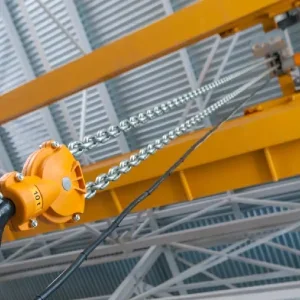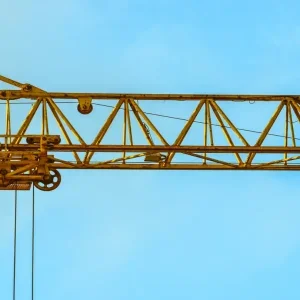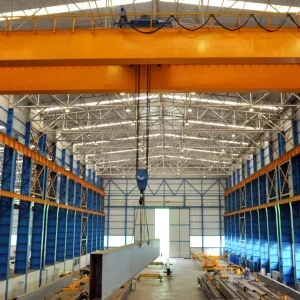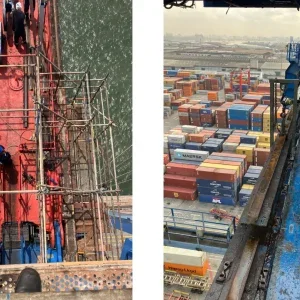The author was involved in a case where he had to carry out necessary inspection / checking to determine whether any structural damage has taken place due to a fire that could have compromised the structural stability of the barge unloader. A fire engulfed in the polyurethane liner of the hopper and could be noticed at midnight and then the fire fighting team took the situation under control.
Due to that fire a part of festoon cable, operator’s cabin the wire ropes were burnt. All the electrical components of the cross travel trolley got completely burnt due to that effect. But more significantly the central part of the main box girder got damaged most.
During Inspection it is also noted that one tie beam, one cross beam member visibly bent by a large extent. The inspection was based on visual, manual and functional examination.
Background
The cross girder of the Barge Unloader is the main load bearing member which transfers the load to the Portal Leg of the machine. It is of utmost importance to investigate in detail that how much damage it has got due to the fire.
It is noticed that the both the web plates of the main box girder got deformed heavily other than spot punching effect. Top and bottom flange plate also got distorted. The spot punching effect in the girder web and flange plate is may be due to the effect of water jets from fire hoses on red hot steel plates.
In a dock environment (sea side), it is impossible to obtain conditions conducive to full quenching. Fire hoses or sprinklers apply a fraction of the water required for quenching and do not create a full quenching environment. At the same time Water from fire hoses actually applies a temporary, non-symmetrical cooling pattern that can precipitate or contribute to buckling of the steel structure.
Due to sudden cooling the steel plates and welded joints are liable to be brittle and develop cracks. The joints may also suddenly fail under dynamic loading without any prior warning.
Water is corrosive with steel, and the rapid cooling can cause distortion or cracking. However, salt water is even more corrosive than plain water and is a more rapid quench medium than plain water because the bubbles are broken easily and allow for rapid cooling of the part.
A structure exposed to fire is likely to thermally induce environmentally conditions that may alter its properties. Fire represents a transfer of energy from a stable condition to a transient condition as combustion occurs. During this process, the steel temporarily absorbs a significant amount of thermal energy.
Subsequently, the steel structure returns either to stable or unstable condition after cooling to ambient temperatures. During this cycle, individual members may become badly bent or damaged without affecting the stability of the whole structure. Damaged members are indicative of energy redistribution within the member itself and possibly in the whole structure.
Given the thermal expansion of steel, a temperature difference from one location to another will produce yield-level residual stresses. This produced distortions in the slender structural steel, which resulted in buckling failures.
Thus, the failure of the steel was due to two factors: (a) loss of strength due to the temperature of the fire, and (b) loss of structural integrity due to distortion of the steel from the non-uniform temperatures in the fire.
This article primarily addresses the structural integrity of individual members. Prior to evaluating the integrity of fire exposed structural steel it is appropriate to examine some relevant background. The brief explanation of steel fire testing and protection is given by AISC(1969)[1]. The ASTM E119 referenced in this document specifies time-temperature and loading conditions that must be satisfied. After test completion, the structural steel assembly must satisfy certain acceptance criterion.
One such criterion for steel beam assemblies is "For steel beams the temperature of steel shall not exceeded 13000F (7040C) at any location during the classification period nor shall the average temperature recorded by four thermocouples at any section have exceeded 11000F (5930C) during this period."
Unfortunately, local or overall damage and deformation which can occur in a fire are not addressed in this criterion. The absence of a statement acknowledging a level of deformation which does not impact on the structural capacity of the steel member can imply that virtually any deformation that can occur in steel member is not acceptable for future use. Many procedures are available to assess structural steel integrity after fire exposure including visual observations, nondestructive testing and destructive testing (removing samples).
The last method can incorporate chemical composition analysis, mechanical properties (UTS, Yield strength, ductility, toughness etc.), residual stress determination and distribution and metallographic observations. Each procedure will be assessed to examine its relative value in predicting structural steel conditions after fire exposure.
When a piece of carbon steel is quenched at a very faster rate, the new structure if formed, transforms into martensite which is characterized by an angular needle like structure and a very high hardness. If carbon steel is subject to a sever quench or to extremely rapid cooling, a small percentage of the austenite, instead of being transformed into martensite during the quenching operation, may be retained.
Over a period of time, however, this remaining austenite tends to be gradually transformed into martensite even though the steel is not subjected to further heating or cooling. Since martensite has a lower density than austenite, such a change, or "aging" as it is called, often results in an appreciable increase in volume or "growth" and the setting up of new internal stress in the steel.
Inspection Methodology Visual observations
In some cases, well-documented visual observations in the fire exposed structures can provide the most useful information concerning the predicted fire temperature and the resultant structural steel peak temperature. Fire temperature indicators can usually be found within the surrounding fire damaged material. The steel surface itself can provide fire temperature information.
Noticeable, tightly adhering mill scale indicates a steel temperature considerably below 12000F. Structural steel exposed to temperatures above 12000F will develop coarse, eroded surface markedly different from the appearance produced by mill rolling.
Although there are numerous types of coatings, markers and paints, which may be used on structural steel, they usually are not designed to withstand elevated temperatures. At temperatures above 6000F, they usually will have blistered, discolored or even flaked-off depending on the exposure to open flames. Any identifiable residue is an indication that the steel has not reached its critical temperature.
A temperature increase will cause an unrestrained member to increase in length or large forces will develop when restraint exists.
The preceding items are important for establishing fire temperature and observing post-fire behavior. However, assessing the structural steel geometry after the fire is foremost in order to evaluate its condition. After fire exposure, it is convenient to categorize the members as follows:
Category 1:
Straight members that appears unaffected by the fire. This includes members that have slight deformations not easily detected by visual observations (within 2 or 3 times ASTM A6 rolling tolerances).
Category 2:
Members noticeably deformed and straightening is not technically and as well as economically justified.
Category 3:
Members severely deformed and needs replacement.
Once the condition of each individual member is determined, the safety of the whole structure can be established. Camber and sweep of each fire exposed, structural steel member should be determined using appropriate measurement techniques (plumb bob, string line, and laser).
A Category 1, 2 or 3 designation should then be assigned to each member. Most often, the Category 2 or 3 designations can be assigned without measuring because of severe local buckles or excessive deflections.
It is suggested that category 1 straight member require only minimal consideration. Metallurgical or structural degradation does not occur with a Category 1 appearance. For any significant metallurgical degradation to occur, temperatures would have to exceed 13300F.
Prior to reaching this elevated temperature level, buckling or large deflections would certainly occur. Slightly deformed Category 1 members, with deformations greater than rolling tolerances, must be analyzed to determine the repair level. Depending on individual circumstances, the analysis will determine if these members can be accepted unconditionally.
Rehabilitation or replacement of Category 2 members is usually dependent on expediency, economics or overcoming the human psychological rejection of what appears to be damaged steel. In most cases, Category 3 members are obvious and usually rejected without much consideration.
Non-destructive testing
There are several non-destructive test procedures to examine fire-exposed structural steel. The most common technique is surface hardness testing. This test can be utilized to determine the occurrence of a steel transformation due to the heating and accelerated cooling cycle.
The various hardness measurement techniques provide an empirical determination of the approximate tensile strength. When austenite steel (above 16000F) is cooled quickly to ambient temperatures (fully quenched), it results in hardened steel. Consequently, hardness readings on fire exposed steel supposedly indicate that the steel was raised to an elevated temperature and then cooled, thus causing some potential metallurgical degradation.
Destructive testing
Sample removal from the fire-damaged steel members can provide specific physical property and residual stress information. Structural steel exposed to temperatures above 12000F for a period of time generally experiences an inconsequential reduction of yield strength, tensile strength, and ductility, Dill (1960)[2] and Kirby (1986)[3].
Charpy V-notch (CVN) testing of removed samples to determine toughness should only be considered if fatigue loading or a brittle fracture potential exists. Based on existing research, Shanafelt (1984)[4] , there is no reason to suspect normally acceptable steel would have a reduced toughness due to fire exposure.
Residual stresses
Residual stress evaluation is performed by removing instrumented areas or coupon samples from the fire exposed steel member. Prior to coupon removal, either mechanical or electrical strain gages are attached and calibrated with an initial reading taken. The coupon is then carefully removed from the member and the strain is measured until the recorded strain data stabilizes. The difference between initial and final readings indicates the internal member strain at the gage location. Placing gages at carefully chosen locations permits a reasonable prediction of the resultant stress distribution in the member.
METALLOGRAPHY
Steel coupon samples are removed and the surface is polished to a mirror-like finish. The surface is then etched with a weak acid solution, which exposes the steel grain structure. A grain structure that differs from the usual mill rolled grain configuration would suggest a metallurgical or structural change in the steel. Structural steel’s grain structure is usually flat or plate like due to the rolling process.
At a temperature around 12000F, the basic steel carbide constituents undergo a transformation known as "spheroidization of pearlite," The quantity of spheroidal carbides depends on the temperature level above 12000F and the length of time the steel is held at this elevated temperature. Some spheroidal carbides may develop during initial steel production because the final rolling temperatures of most structural steel range from 16000 to 18000F, or higher.
Any presence of spheroidal carbides could suggest a reduction of the yield strength because of the change in grain structure from that produced during rolling. However, research indicates that any reduction in strength is inconsequential. Hapgood (1979) [5] concluded that the absence of spheroidal carbides indicated that the steel was not subjected to unusually high temperatures.
Consequently, the formation of spheroidal carbides in a Category 1 or 2 members is highly unlikely during a fire and their development may have also occurred during production. The elevated temperatures required for their formation during a fire would cause large member deformations, which are inconsistent with the above member classifications.
Specific Observation
Specific visual observation shows that there is substantial structural deformation in the middle section of the main cross girder and it is most likely that the steel has lost its metallurgical and physical properties to a large extent due to sudden extreme heating and cooling effect.
This member may be categorized as Category 3. The middle portion of the cross box girder (1060mm x 1400mm) comprising of steel plates of 8mm, 10mm, 16mm and over a length of about 9.0m is required to be replaced.
It is also suggested that the sample piece from both end of the heat effected girder, which needs replacement, is required to be sent for testing for its metallurgical and physical properties (residual stress, Charpy V-notch) to ascertain that no further damage has taken place in the remaining portion of the girder. If some negative feedback comes then more heat affected part of the girder must be replaced.
It is also observed that the Tie member and Cross bracing member adjacent to the main cross girder on the land side are found to be visibly bent / deformed and can be categorized as Category 2 member. It is very difficult or impossible to straighten the member keeping the same in location. It is also not advisable to straighten the member by bringing it in ground.
Trying to straighten the members by any means at ground may induce additional mechanical stress in the member which in turn will substantially reduce its capacity. So it is always recommended / advisable to replace those two members by a newly fabricated one.
Some members may be categorized as Category 1 member as there are some visible effects of fire into the member as because the visible observations do not reveal any deformation or may be it got some deformation due to fire effect, which may be within 2 to 3 times of rolling tolerance of plate. As such the deformation must be established by appropriate measurement techniques before finally assigning its category.
If the member is established as Category 1 member then it requires minimum consideration as we know that metallurgical and structural degradation does not occur with a Category 1 appearance. For any significant metallurgical degradation to occur, temperatures would have to exceed 13300 F.
Prior to reaching this elevated temperature level, buckling or large deflections would certainly occur. If we can establish it as Category 1 member then we can use it unconditionally subject to UT testing in welding in the most heat affected area and UT testing in plates to find out any laminations of plates. Hardness measurement (nondestructive testing) is required to be carried out which will provide some empirical / approximate determination of the tensile strength of plates.
Conclusion
The first impression upon arriving at a fire scene is usually very negative because of the immense destruction and adverse environmental conditions. Field assessment of fire damaged steel member requires a systematic approach to determine their condition.
Based on practical experience, a member inventory should be performed and each member should be classified as elaborated earlier in this report. Visual observation and measuring the member geometry provide the most practical means to classify and assess the potential for damage in a fire exposed member.
The repair or replacement of an individual member is dependent on classification, location in structure, importance and economics. Nondestructive and destructive testing may provide interesting information on the steel post fire pedigree. In conclusion, it can be simply stated: "If it is still straight after exposure to fire – the steel is O.K." A similar statement was made 40 yrs ago and is still applicable.






